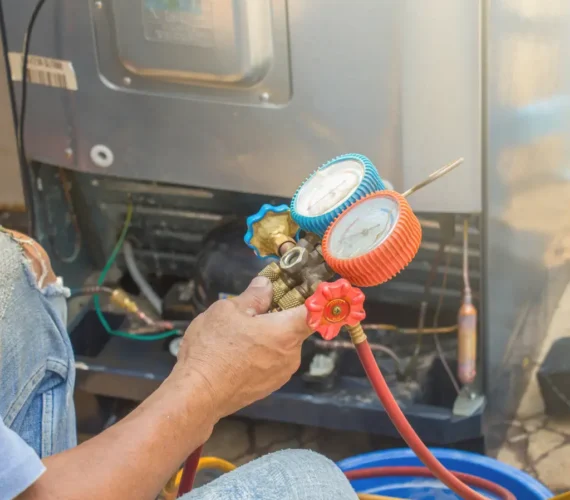
Refrigerator Gas Filling: A Comprehensive Guide to Efficient Cooling
Refrigerators play a crucial role in keeping food fresh and beverages cool. However, over time, your fridge may lose its cooling efficiency due to low refrigerant levels. If your refrigerator is not cooling effectively, it might be time for a gas refill. In this guide, we will explore everything you need to know about refrigerator gas filling, including signs of low refrigerant, the types of refrigerants used, the filling process, and maintenance tips to keep your appliance running efficiently.
Why Is Refrigerator Gas Important?
Refrigerator gas, or refrigerant, is a chemical compound that circulates through the cooling coils to absorb heat and maintain a cool environment inside the fridge. It undergoes phase changes, from liquid to gas, enabling the removal of heat from the interior. Without sufficient refrigerant, the cooling process becomes ineffective, leading to spoiled food and higher energy consumption.
Signs Your Refrigerator Needs a Gas Refill
Knowing when to refill the refrigerant is crucial to avoid costly repairs. Here are some common signs indicating low refrigerant levels:
- Inadequate Cooling: The most obvious sign is that the refrigerator is not cooling properly, even when the thermostat is set to the correct temperature.
- Continuous Running: If the compressor runs non-stop without cycling off, it could indicate a refrigerant shortage.
- Frost Build-Up: Ice accumulation on the evaporator coils could suggest refrigerant issues.
- Unusual Noises: A refrigerator running on low refrigerant might produce gurgling or hissing sounds.
- Higher energy bills: Reduced cooling efficiency can lead to increased energy consumption and higher electricity bills.
Types of Refrigerants Used in Refrigerators
Different types of refrigerants are used based on environmental regulations and the design of the refrigerator. Common types include:
- R-134a (HFC-134a): Commonly used in older refrigerators, it is less harmful to the ozone layer but still contributes to global warming.
- R-600a (isobutane): A popular, eco-friendly refrigerant used in modern refrigerators due to its low Global Warming Potential (GWP).
- R-410A: Though primarily used in air conditioners, some refrigerators may utilize it for enhanced efficiency.
- R-22 (Freon): Phased out in many countries due to its ozone-depleting properties.
Refrigerator Gas Filling Process
Refilling the refrigerant is a delicate process that requires precision. Here’s a step-by-step outline of how professionals typically perform the task:
1. Safety Precautions
Ensure the refrigerator is unplugged, and wear protective gear such as gloves and safety goggles to prevent contact with refrigerant gases.
2. Identify the Leak
Before refilling, check for leaks in the refrigerant system using a leak detector or soapy water. Repair any leaks found to prevent future refrigerant loss.
3. Evacuate Existing Refrigerant
If necessary, the old refrigerant is removed using a recovery machine to ensure the system is clean and ready for a refill.
4. Attach Gauges and Charging Hose
Connect a manifold gauge set to the refrigerator’s service valve. The gauges help monitor pressure levels during the refill process.
5. Refilling the Refrigerant
Using a refrigerant canister, slowly add the gas while monitoring the pressure levels on the gauges. Ensure the correct amount is added based on the manufacturer’s specifications.
6. Test for Proper Operation
Once the refrigerant is refilled, turn on the refrigerator and check for proper cooling performance. Ensure the temperature stabilizes within the optimal range.
Why Professional Help Is Recommended
While it may be tempting to refill the refrigerant yourself, it is highly recommended to seek professional assistance. Refrigerant handling requires specialized equipment and knowledge of pressure dynamics. Incorrect handling can lead to:
- Personal Injury: Refrigerants can cause skin burns and respiratory issues.
- Environmental Damage: Improper handling can release harmful gases into the atmosphere.
- Damage to the Appliance: Overfilling or underfilling can damage the compressor and other components.
Maintenance Tips to Prevent Refrigerant Issues
To keep your refrigerator running efficiently and avoid frequent refrigerant refills, follow these maintenance tips:
- Regular Cleaning: Clean the condenser coils at least twice a year to prevent dust buildup.
- Check Door Seals: Ensure the door gaskets are airtight to prevent warm air from entering.
- Proper ventilation: Ensure the refrigerator is placed in a well-ventilated area to avoid overheating.
- Avoid Overloading: Do not overcrowd the refrigerator, as it restricts air circulation.
- Monitor Temperature Settings: Keep the fridge temperature between 37-40°F (3-5°C) and the freezer at 0°F (-18°C).
Conclusion
Refrigerator gas filling is essential for maintaining optimal cooling efficiency. Recognizing the signs of low refrigerant, understanding the types of refrigerants, and following proper maintenance can extend the life of your appliance. While it may seem simple, refrigerant refilling is best left to professionals to ensure safety and compliance with environmental regulations. Regular care and timely servicing will keep your refrigerator running smoothly and efficiently for years to come.
